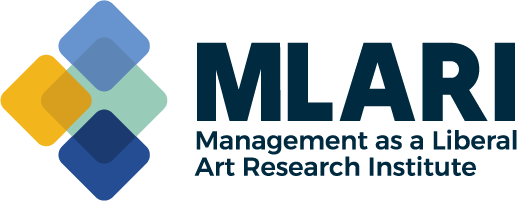AI as an Enabler of Management as a Liberal Art
PUBLISHED:
What is MLA?
Management as a Liberal Art (MLA), a concept championed by Peter Drucker views management not only as a technical practice focused on performance but as a humanistic discipline focusing on people, values, and the common good. In a previous blog post, I introduced the three knowledge pillars of MLA by proposing that the knowledge of individual and societal characteristics is as important as the knowledge of organizational drivers of performance. Therefore, I concluded that managers practicing MLA need to acquire and maintain a good understanding of individual-level, organization-level, and society-level factors that impact business operations. In that post, I also discussed how knowledge of various disciplines such as psychology, history, and political science, among others, can lead to a better understanding of these three pillars of MLA.
In this blog post, my goal is to discuss how recent developments in Artificial Intelligence (AI) can enhance effective implementation of MLA by facilitating the access, interpretation, and maintenance of multi-disciplinary knowledge pertaining to individual, society, and organization.
What is AI?
AI (Artificial Intelligence) refers to the use of computational systems that simulate human cognitive functions, such as learning, reasoning, and decision-making, to collect, process, and interpret vast amounts of data. It can transform raw data into actionable insights by identifying patterns, making predictions, and suggesting solutions. While the term AI was coined around 1956, it only recently gained significant popularity due to the confluence of data proliferation, algorithmic advancement, and enhanced computational capacity and storage.
AI and MLA
At first glance, AI and MLA might seem at odds. MLA emphasizes human judgment, ethics, and values, while AI is often associated with data-driven efficiency and automation, which could be perceived as undermining the human elements central to MLA. However, these approaches are not inherently conflicting. Instead, AI can complement MLA by enhancing human-centered decision-making and supporting value-based aspirations.
AI can play a significant role in enabling managers to put the MLA philosophy into practice. Recent AI developments facilitate the effective and efficient collection and analysis of individual, societal, and organizational data in ways that were not possible before. While predictive AI tools have existed for decades to facilitate analysis of technical organizational and industrial data, the recent advancements in natural language processing (e.g., large language models) and generative AI have opened new horizons for interpretation and analysis of existing knowledge in the realm of social sciences. In other words, generative AI enables a fast acquisition and interpretation of written information from knowledge sources that were not easily accessible decades ago. In essence, summarization of existing written knowledge about specific topics in philosophy, history, or other social sciences can take place in a matter of seconds. Therefore, gaining fundamental technical information about individual and societal factors that impact management is less costly or time consuming than before. Similarly, advanced AI tools and systems can collect and analyze large amounts of data from a variety of sources in real time to offer managerial insights.
Below, I explore AI’s role in helping managers gain a deeper understanding of organizational-level, individual-level, and society-level influences. Although individuals are embedded within organizations and societies, examining these entities separately offers a clearer view of how AI transcends different levels of analysis.
AI Helping Managers Understand the Organization
AI’s predictive capabilities allow managers to analyze internal data to identify problems and to predict potential financial and operational risks directly relevant to organizational performance. This leads to more proactive decision-making and strategic planning within the organization. Similarly, AI-powered tools facilitate better internal communication and collaboration by analyzing interaction patterns, identifying communication bottlenecks, and suggesting ways to improve information flow throughout the organization. As another example, AI can automate routine reporting tasks and dashboards, giving managers real-time insights into how various parts of the organization function.
AI Helping Managers Understand Individuals
Organizations monitor employee performance, measure productivity, and provide personalized recommendations for professional development. AI tools can take the quality of these recommendations to the next level by considering employee characteristics (e.g., personality) or other outcomes (e.g., job satisfaction). AI-based tools, such as the ones built on psychometric tests, can analyze language patterns and behavior to infer personality traits. By understanding an individual’s traits (e.g., introversion/extroversion, openness to experience), the AI can suggest tailored professional development paths. Similarly, sentiment or emotion analysis can help managers understand the ongoing needs of their employees. For instance, modified LLMs can analyze written or spoken communication (emails, chat messages, or voice inputs) to detect sentiment and emotional tone. This can help gauge mood and satisfaction, giving a sense of an employee’s emotional state over time. If used properly, these insights can help managers boost organizational outcomes by improving job satisfaction and minimizing employee burnout or turnover. It is important to note that establishing clear guidelines and ethical frameworks for the use of AI tools is important to prevent issues related to privacy and ethics. Transparency in informing employees of the purpose and scope of AI-based monitoring is also important. Implementing guardrails such as data privacy protocols and ethical oversight committees can also help prevent misuse and ensure AI tools are used to enhance trust rather than erode it.
AI Helping Managers Understand the Society
AI can help managers understand different cultural and demographic trends by analyzing large datasets that reveal societal changes, consumer behaviors, and global shifts in market demands. For instance, AI tools can analyze social media conversations, news articles, and public forums to gauge public sentiment, identify trends, and understand societal expectations or concerns. Similarly, AI tools can also be used to model the environmental impact of a company’s operations or decisions, helping managers evaluate sustainable practices the benefit different stakeholders. For instance, a company planning to expand manufacturing facilities can use AI to better estimate the carbon emissions resulting from increased production. AI tools can simulate the long-term environmental impacts, such as air and water pollution, as well as public health consequences. Based on these predictions, managers may choose whether to implement more energy-efficient technologies.
AI significantly shortens the gap between when a trend starts and when managers can detect it. Unlike traditional methods where data lag behind real-time developments, AI’s real-time data analysis and predictive capabilities allow organizations to see trends as they emerge, not years later. This immediate access to information enables managers to respond proactively, rather than reactively, to shifts in the marketplace or societal expectations.
Concluding Remarks
While MLA focuses on nurturing a holistic view of management, AI can provide insights and tools that allow managers to efficiently gain a comprehensive understanding of the organizational dynamics within their proper context. This in turn, gives managers a better understanding of various individual and societal factors surrounding a business problem. Rather than replacing human insight, AI can empower managers to make more informed, value-aligned decisions, reinforcing the core principles of MLA.





